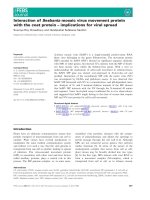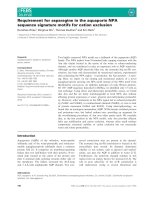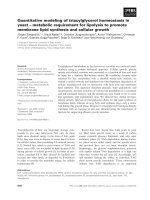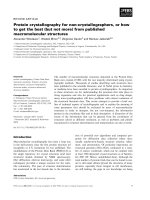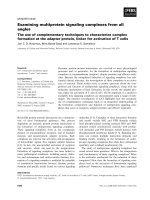Optimal dietary protein requirement for juveni
Bạn đang xem bản rút gọn của tài liệu. Xem và tải ngay bản đầy đủ của tài liệu tại đây (6.22 KB, 1 trang )
Jian-Bin Zhou, Qi-Cun Zhou, Shu-Yan Chi, Qi-Hui Yang, Chu-Wu Liu, 2007.
Optimal dietary protein requirement for juvenile ivory shell, Babylonia areolata.
Aquaculture. 270(1-4):186-92.
Abstract
A growth experiment was conducted to determine the optimal dietary protein
requirement for juvenile ivory shell reared in indoor aerated aquaria. Six
isoenergetic experimental diets using fish meal, casein and gelatin as protein
sources were formulated to contain graded levels of protein (27, 33, 38, 43, 49 and
54% of dry diet, respectively). Triplicate groups of 40 shells (average weight 93.50
± 1.70 mg) were stocked in 120-l tanks and fed to apparent satiation twice daily for
8 weeks. The results showed that the growth performance and feed utilization were
significantly affected by dietary protein level (P < 0.05). Maximum weight gain,
mean protein gain, specific growth rate and soft body to shell ratio occurred at 43%
dietary protein level (P < 0.05). There were significant differences in protein, lipid,
moisture and ash content in soft body; except that ash content in shell was not
significantly affected by dietary protein level. Pepsin activity in soft body tissue
significantly increased with dietary protein level up to 43%, and trypsin-like
enzyme activity increased with dietary protein level up to 49%. However, lipase
activity in soft body decreased with increasing dietary protein level. However, no
significant differences (P < 0.05) in survival, calcium, phosphorus concentration in
the shell and soft body were found among dietary treatments. Quadratic regression
analysis of weight gain against dietary protein level indicated that the optimal
dietary protein requirement for maximum growth and feed utilization of juvenile
ivory shell is 45% of dry diet.


